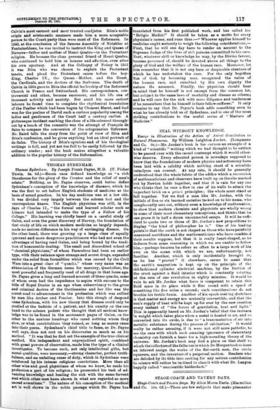ZEAL WITHOUT KNOWLEDGE.
Essays in Illustration of the Action of Astral Gravitation in Natural Phenomena. By William Leighton Jordan. (Longmans and Co. 9s.)—Mr. Jordan's book is too curious an example of a kind of " scientific " writing which we had thought to be extinct to be passed over with the casual contempt which it would other- wise deserve. Every educated person is nowadays supposed to know that the foundations of modern physics and astronomy have been laid with a solidity which nothing short of a scientific cataclysm can overset. At any rate, it should be generally understood that the whole fabric of the edifice which a succession of mathematicians and observers have built up on the site marked out by Newton holds together, and that it is vain for any one who thinks that lie sees a flaw in one of its walls to attack the imperfect brick on a priori principles ; the whole must stand or fall together. Yet we find a man like Mr. Jordan, with the initials of five or six learned societies tacked on to his name, who complacently sets out, without even a knowledge of mathematics, to show that modern chemists and physicists are wholly wrung in some of their most elementary conceptions, and thinks that he can prove it in half a dozen unconnected essays. It will be suffi- cient to quote two or three of Mr. Jordan's new propositions to display "the kind of philosopher he is." One of his leading points is that the earth is not shaped as those who have painfully measured meridians and the mathematicians who have combiru d their results suppose, but that it is really heart-shaped, as he deduces from some reasoning in which we are unable to follow him,—perhaps because he refers so often to a large work of his own on the ocean with which we are, unfortunately, not familiar. Another, which is only incidentally brought in, as he has " proved " it elsewhere, seems to mean that the earth's magnetism is kept up on the principle of the old-fashioned cylinder electrical machine, by the friction of the crust against a fluid interior which is constantly rotating at the rate of one revolution in eighty minutes. It would be vain to ask Mr. Jordan what force is competent to retain this fluid mass in its place while it flies round with a speed of something like five miles a second ; such considerations do not trouble his fertile brain. Another of his epoch-making doctrines is that matter and energy are mutually convertible, and that the sun's supply of heat will be kept up for ever by the new creation every instant of "the forces of gravitation, heat and light." This is apparently based on Mr. Jordan's belief that the increase in weight which takes place when a metal is heated in air, and so converted into its oxide, is due to "a transmutation of air into metallic substance during the process of calcination." It would really be rather amusing, if it were not still more pathetic, to see the ease with which such amazing ignorance of elementary chemistry can furnish a basis for a high-sounding theory of the universe. Mr. Jordan's book may find a place on that shelf to which thecollectors of the fallacies in which De Morgan took so keen an interest assign the works of the flat-earth men, the circle squarers, and the inventors of a perpetual motion. Readers who are deluded by its title into seeking for any serious contribution to science will rather be inclined to class it with what Dr. Lanyon happily called "unscientific balderdash."


















































 Previous page
Previous page